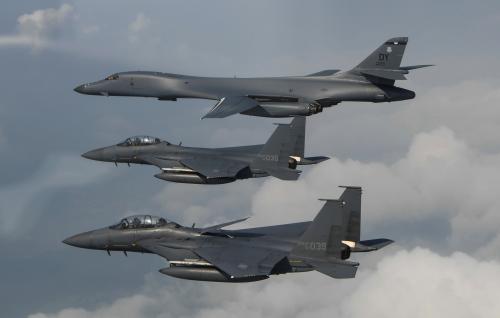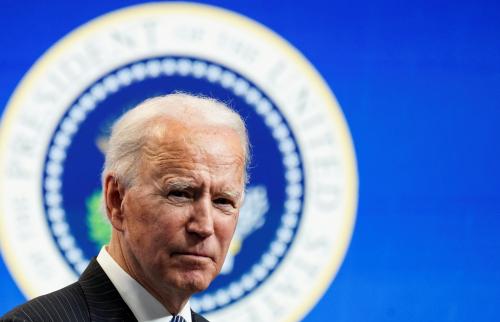George W. Bush came to office promising to “leave the cold war behind” and “rethink the requirements for nuclear deterrence”. Last week, the Pentagon released the results of its Nuclear Posture Review, which seeks to put flesh on the bones of Mr. Bush’s campaign vision.
On the surface, the results are impressive. Over the next 10 years, the US proposes to reduce its strategic nuclear arsenal from the 7,200 warheads it currently deploys to between 1,700 and 2,200. Although the administration plans to enact these cuts unilaterally, it expects Russia to reciprocate.
Looked at more closely, however, the review falls woefully short. It perpetuates rather than breaks with the cold war logic on nuclear weapons that Mr. Bush has rightly dismissed as “outdated”. The planned reductions are readily reversible, Russia remains the target of US nuclear forces, and the aversion to negotiating binding limits is likely to generate distrust and undermine the stability that arms reductions would otherwise engender.
Although Pentagon officials describe the planned cuts as historic, they are essentially identical to the 2,000-2,500 range that President Bill Clinton proposed in 1997. Mr. Bush gets his slightly lower numbers only through an accounting gimmick—changing the long-standing rule for counting nuclear weapons. The administration no longer counts in the force totals the 200-400 warheads normally deployed on weapons systems that are being overhauled.
More worrying is the fact that Mr. Bush is not pledging to destroy any warheads. Instead, most—if not all—will be put in storage. Moreover, with the exception of the long-planned dismantling of 50 MX land-based missiles and the conversion of four Trident submarines, the Pentagon plans to maintain its entire inventory of ballistic missiles and bombers. As a result, the US will be able to reconstitute a large nuclear force in a matter of weeks or months.
The result is that instead of cutting the US nuclear arsenal, the Bush administration is merely taking a large part of the force off day-to-day alert. Even then, it plans to make these modest changes over 10 years. This is not very impressive when you consider that in 1991 Mr. Bush’s father needed only weeks to take the entire US bomber force and 450 land-based missiles off alert.
Why is there so little—and such slow—change in the American nuclear posture? There are two reasons.
First, although Mr. Bush says that “the premises of cold-war nuclear targeting should no longer dictate the size of our arsenal”, they still do. The Pentagon continues to presume that successful deterrence requires the US to be able to attack about 2,200 targets in Russia alone. This number will fall as the Russian arsenal shrinks but the targeting philosophy will remain unchanged. So, at the same time that Mr. Bush proclaims his trust in Russia, US nuclear strategy remains wedded to old assumptions about Russia as America’s enemy.
Second, the administration argues that in an uncertain world, the US must retain the flexibility to respond rapidly to any future threats that may arise. That is why the Pentagon calls the stored weapons a “responsive force”. That is also why the administration has rejected Moscow’s entreaties to negotiate binding limits on future force levels.
This approach carries real dangers. If the US retains flexibility, so does Russia. For now, Vladimir Putin, Russia’s president, is likely to follow Mr. Bush and put thousands of warheads on the shelf. But a future Russian government may choose, perhaps because of a dispute with the west or fear of a rising China, to return its “responsive force” to active duty. Even without such a development, Russian weapons in storage are vulnerable to theft.
What would a true post-cold war nuclear posture look like? The US does not have the option of “un-inventing” nuclear weapons. But it should work with Russia to diminish their role in world politics.
To do that, Washington and Moscow should reduce their offensive forces to 1,000 weapons or less—and destroy the rest. The prospect of tens, let alone hundreds, of nuclear weapons exploding on one’s territory is sufficient to deter anyone.
These reductions must be codified in a treaty. This legally binding agreement must not only limit missiles and warheads but also provide for thorough, on-site inspection and other forms of verification. Without a treaty, uncertainty about future intentions and capabilities will promote suspicion and could undermine the continuing rapprochement between Washington and Moscow.
Mr. Bush’s proposed nuclear weapons cuts fall well short of his promised “rethinking” of US nuclear weapons policy. A decade after the cold war ended, it is time to put aside the smoke and mirrors and to make truly fundamental changes in America’s approach to nuclear weapons.


Commentary
Op-edStuck in the Cold War
January 14, 2002